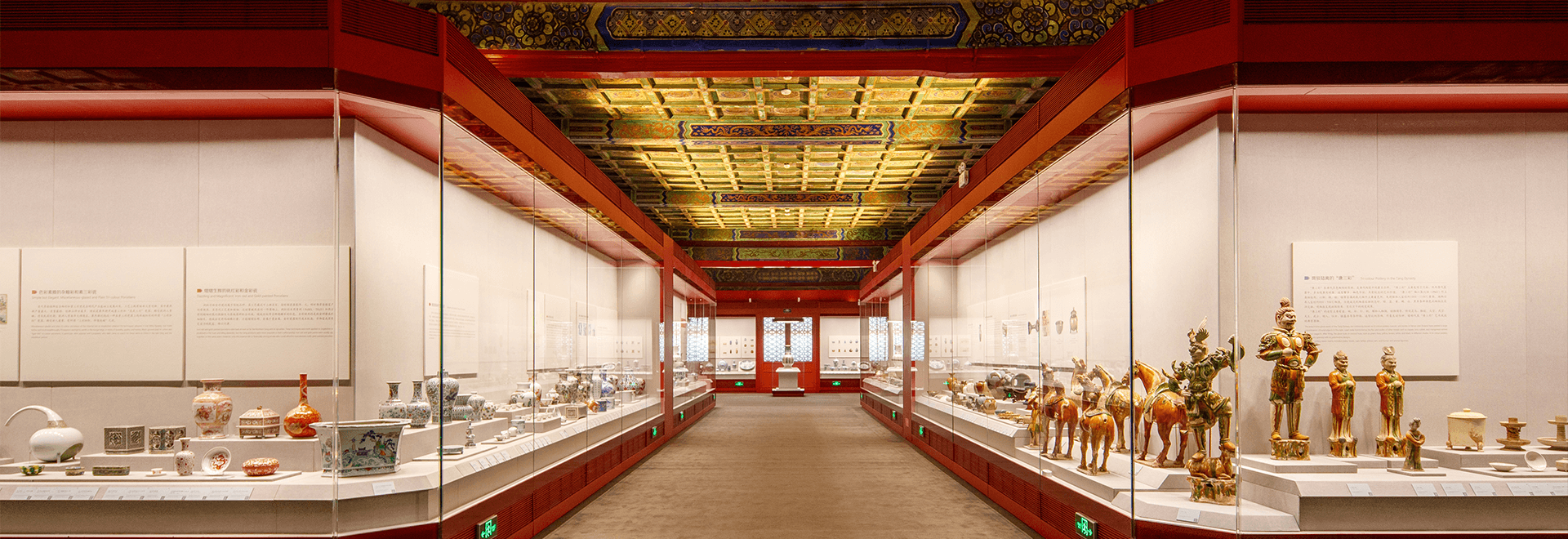News
2025-07-16
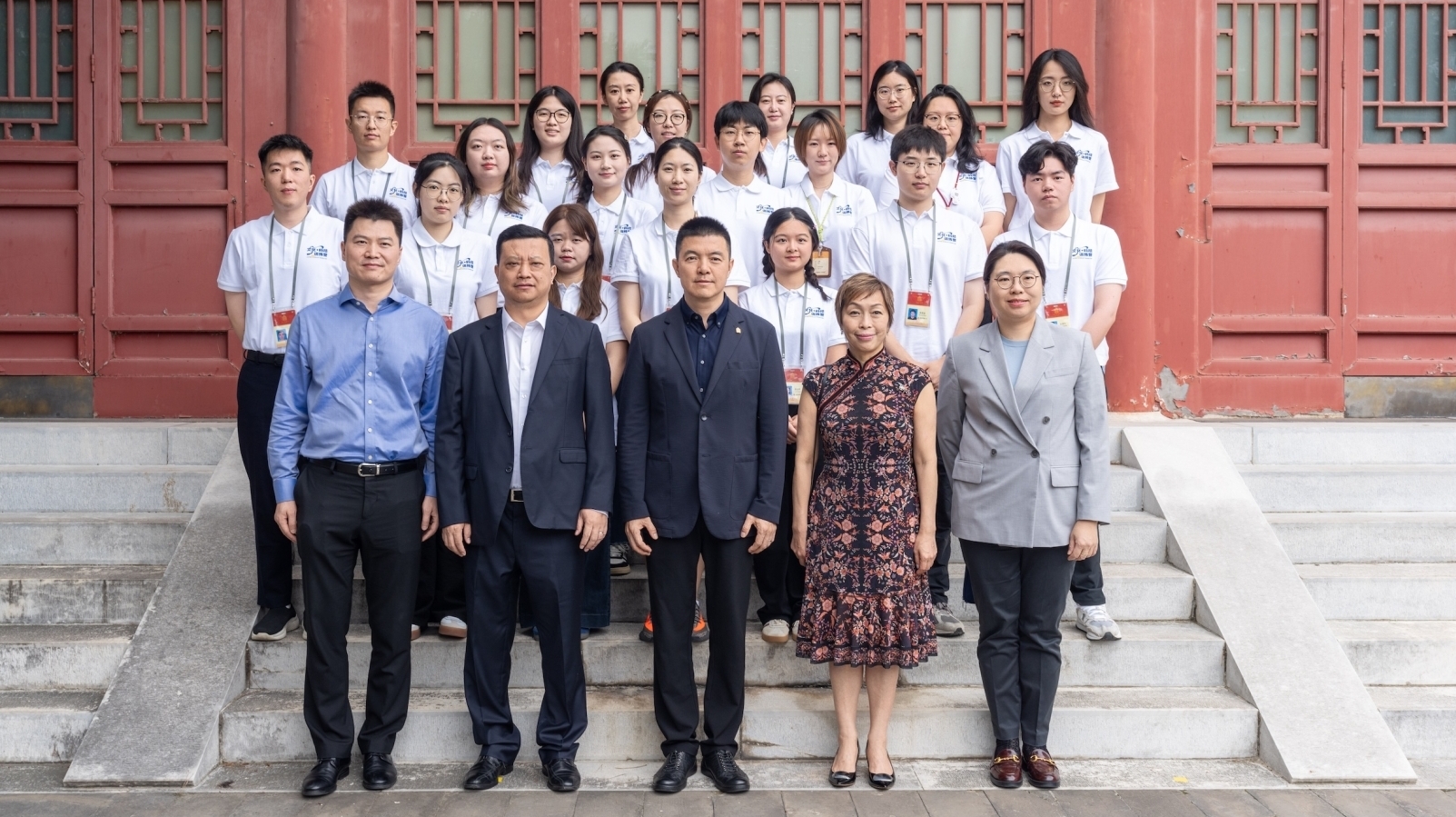
Palace Museum Unveils English and Traditional Chinese Versions of Youth Website and Launches 2025 “Culture + Technology Training Camp”
On July 8, the Palace Museum held a ceremony to mark the launch of the English and Traditional Chinese versions of its youth website and the opening of the 2025 “Culture + Technology Training Camp” for young cultural professionals from Hong Kong and the Palace Museum. As the summer vacation begins, the Palace Museum aims to enrich young people’s cultural experiences through both online and offline activities. The event was organized by the Palace Museum and exclusively sponsored by the Institute of Philanthropy (IoP).
Among the guests attending were Lou Wei, executive deputy director of the Palace Museum, Ann Kung Yeung Yun Chi, deputy chairman of IoP and Trustee of The Hong Kong Jockey Club Charities Trust, Huang Yulong, director of the Academy of Translation and Interpretation of China International Communications Group (CICG), and Eunice Chan Yin Ting, assistant director of the Office of the Government of the HKSAR in Beijing.
In his address, Lou Wei noted that the Palace Museum stands as a brilliant testament to millennia of Chinese civilization, serving as a vital bridge that connects generations with their cultural heritage. General Secretary Xi Jinping has said that “In the drive to advance the building of a strong country and the realization of national rejuvenation through Chinese modernization, there is much that young people can achieve.” He encouraged young people to make full use of the Palace Museum’s resources to learn about traditional culture, gain knowledge and confidence, and take an active role in preserving and sharing this heritage. He also expressed hope that their skills and fresh ideas would help advance the development of culture and technology.
Lou Wei, executive deputy director of the Palace Museum, delivers a speech in Beijing, July 8, 2025.
Ann Kung Yeung Yun Chi said that the launch of the website’s English and Traditional Chinese versions represents a key milestone in the five-year partnership between the Institute of Philanthropy and the Palace Museum. She hoped the interactive website would help young people worldwide learn about and engagingly appreciate the vastness of Chinese culture. She also encouraged the participants of the inaugural “Culture + Technology Training Camp” to seize this valuable opportunity to explore how digital technologies can be applied to cultural heritage preservation and promotion, and to contribute to innovation and integration in the cultural and tourism industry.
Ann Kung Yeung Yun Chi, deputy chairman of IoP and Trustee of The Hong Kong Jockey Club Charities Trust, delivers a speech in Beijing, July 8, 2025.
The Palace Museum’s youth website, first launched in 2015, focuses on delivering knowledge in engaging ways tailored for young audiences. It offers hand-drawn illustrations, interactive tour routes, games, micro-animations, audio-visual content, and digital notebooks, creating an educational and entertaining platform on Chinese traditional culture. Professional teams from the CICG Academy of Translation and Interpretation translated the newly-launched English and Traditional Chinese versions. They developed tailored translation strategies accounting for linguistic and contextual differences to reach multiple target audiences. Key content from the simplified Chinese version of the youth website, including news, visitor guides, exhibitions, architecture, collections, and court history, has been made accessible in both English and Traditional Chinese.
The 2025 “Culture + Technology Training Camp” focuses on talent development, recruiting young cultural practitioners from four Hong Kong universities and the Palace Museum for a training program centered on the theme of culture and technology. The camp features lectures from experts, field studies, group discussions, and workshops designed to promote traditional Chinese culture, cultivating professionals with global perspectives and innovative capabilities in cultural and technological integration. This training camp is part of the five-year collaborative initiative “Promotion of Chinese Culture and Arts Tech Talent Development in the Mainland and Hong Kong” between the Palace Museum and the IoP. The inaugural camp will run from July 7 to August 3, 2025.
Guests and participants of the training camp pose for a group photo in Beijing, July 8, 2025.
Looking ahead, the Palace Museum will continue to leverage its extensive cultural resources, deepen the integration of culture and technology, and develop new approaches to promote traditional Chinese culture. By doing so, it aims to nurture more professionals with strong expertise and creativity in cultural communication and technology.
2025-06-10
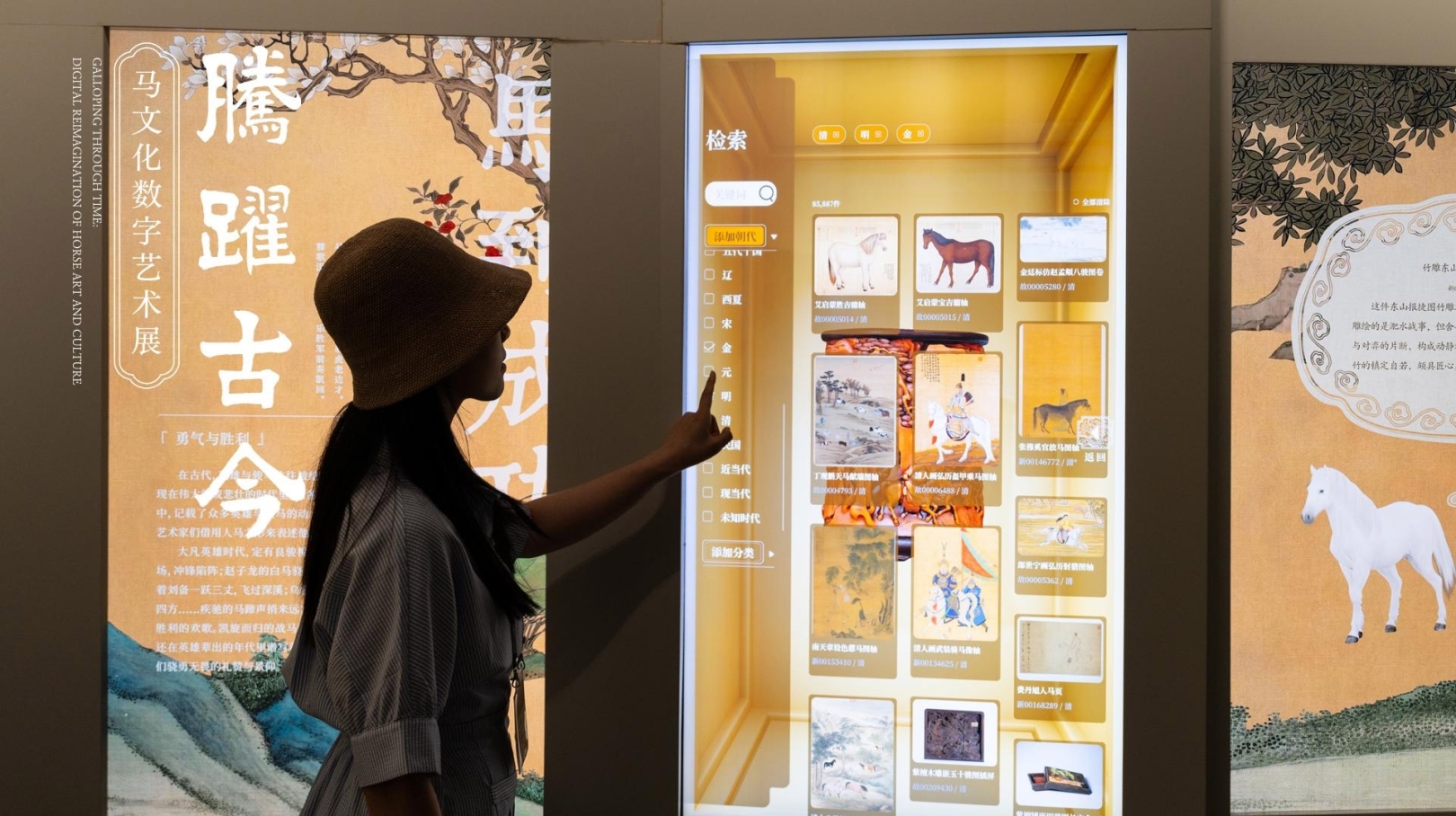
“Galloping through Time: Digital Reimagination of Horse Art and Culture” Opens at the Palace Museum
Building on its rich collections and commitment to openness and sharing, the Palace Museum opened its latest exhibition “Galloping Through Time: Digital Reimagination of Horse Art and Culture” at the Great Hall of Exalted Mystery (Dagaoxuan dian). The exhibition is now open for group bookings from primary, secondary, and university students. Organized by the Palace Museum and exclusively sponsored by the Institute of Philanthropy (IoP), the exhibition offers visitors an immersive digital experience. As an interactive platform for art appreciation and knowledge exploration it can help young audiences deepen their understanding of preserving and carrying forward fine traditional Chinese culture.
The opening ceremony was attended by Wang Xudong, a member of the Party Leadership Group of the Ministry of Culture and Tourism (MCT) and director of the Palace Museum; Lester Huang, IoP chairman and trustee of the Hong Kong Jockey Club Charities Trust; and Winfried Engelbrecht-Bresges, IoP director and CEO of the Hong Kong Jockey Club. Other attendees included representatives from the MCT, the National Cultural Heritage Administration (NCHA), the China Soong Ching Ling Foundation, the Beijing Xicheng District People’s Government, the Office of the Government of the Hong Kong Special Administrative Region in Beijing, the Hong Kong Jockey Club, Tsinghua University, Beijing Normal University, and the Forbidden City Cultural Heritage Conservation Foundation. Lou Wei, executive deputy director of the Palace Museum, and IoP chairman Lester Huang delivered speeches on behalf of their respective organizations. Zhu Hongwen, deputy director of the Palace Museum, presided over the opening ceremony.
The Great Hall of Exalted Mystery is the Palace Museum’s second fully digital exhibition hall. The Palace Museum has created a real-time digital system that connects its storage, database, and exhibition space, allowing visitors to access and explore a vast collection of over 100,000 digitized artifacts. The exhibition hall is a versatile space that combines exhibition, research, and education. The exhibition “Galloping through Time: Digital Reimagination of Horse Art and Culture” highlights the symbolic significance of the horse and its close ties to human civilization. It features over 500 ultra-high-resolution images of horse-related artifacts from the Palace Museum’s collection. Advanced technologies including immersive projections, 3D interactions, and knowledge mapping help visitors experience these rare cultural relics in new ways.
In his speech, Lou Wei noted that in recent years, the Palace Museum has intensified efforts to complete archival imaging of nearly one million artifacts in its collection, making them publicly available through digital platforms such as the “Digital Cultural Relics Database” and “The Palace Museum’s Masterpieces.” As the Palace Museum’s “Version 3.0” digital exhibition space, the Great Hall of Exalted Mystery represents a major step forward in the museum’s efforts to digitally preserve and share cultural heritage. It not only brings out the rich value of digital artifacts but also plays an increasingly important role in academic research and youth education. He explained that the exhibition is part of the “Promotion of Chinese Culture and Arts Tech Talent Development in the Mainland and Hong Kong” initiative, supported by IoP. Guided by the principles of openness, innovation, and collaboration, both partners are committed to pushing for creative transformation and innovative development of fine Chinese traditional culture, Lou said.
Lester Huang said in his speech that the partnership between IoP and the Palace Museum aims to promote traditional Chinese culture, nurture talent in art and technology, and support Hong Kong’s development as a hub for international cultural exchange between China and the rest of the world. He noted that this horse-themed exhibition builds on the Palace Museum’s rich cultural legacy, and that the horse artifacts from various dynasties reflect the spirit of their eras and embody the deep cultural admiration the Chinese people have long held for the horse. He also expressed hope that through this exhibition, more young people will be inspired by the values of courage, perseverance, and diligence embodied by the horse — and will experience the power of cutting-edge digital technology.
The “Galloping through Time: Digital Reimagination of Horse Art and Culture” exhibition at the Great Hall of Exalted Mystery will begin accepting group reservations from primary, secondary, and university students starting June 4, 2025. Reservations can be made by calling 400-950-1925. Capacity is limited each day and available on a first-come, first-served basis. Visitors must present a valid ID and arrive on time according to their confirmed reservation.
2025-05-26
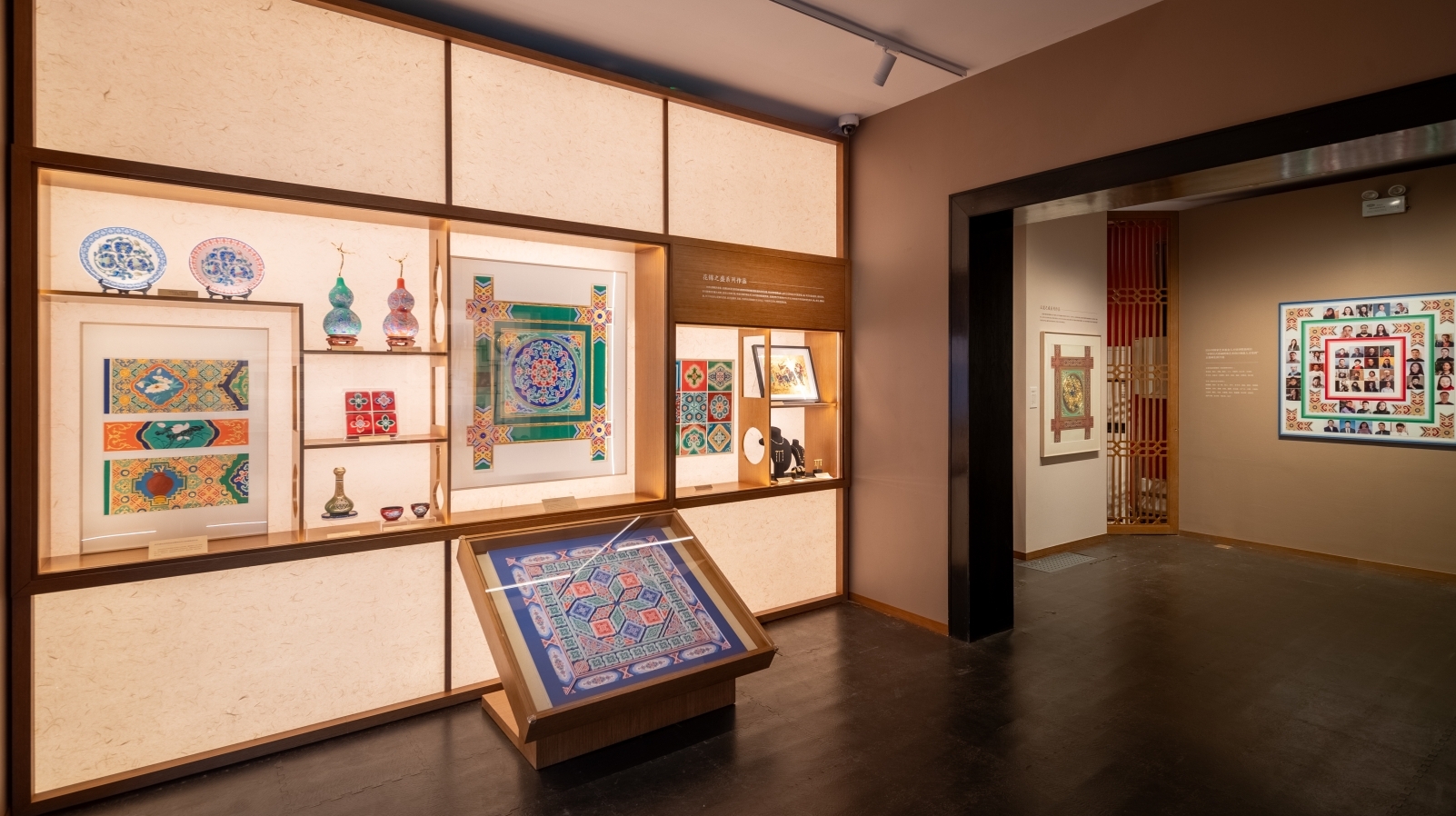
“A Thousand-Year Legacy of Caihua: Inheritance and Innovation in Official-Style Chinese Architectural Polychrome Painting” Opens at the Palace Museum
On May 26, 2025, the exhibition “A Thousand-Year Legacy of Caihua: Inheritance and Innovation in Official-Style Chinese Architectural Polychrome Painting” opened to the public at the Palace of Eternal Longevity (Yongshou gong) in the Palace Museum. The opening ceremony took place on the same day, attended by Wang Xudong, director of the Palace Museum; Du Haijiang, Party secretary and deputy director of the Palace Museum; Lou Wei, executive deputy director of the Palace Museum; Yang Zhouxian, deputy director of the management center of China National Arts Fund (CNAF); Deng Chao, director general of the Department of Cultural Relics and Historic Sites at the National Cultural Heritage Administration (NCHA); Li Bingzhong, vice president of Shaanxi Normal University; Li Li, deputy director of the China Academy of Cultural Heritage; along with teachers and student representatives from the training program funded by CNAF— “Talent Training on the Official-Style Chinese Architectural Polychrome Painting Design.” Zhao Peng, deputy director of the Department of Architectural Conservation Management at the Palace Museum, presided over the ceremony.
In his speech, Lou Wei emphasized that official-style Chinese Caihua (architectural polychrome painting) represents a traditional art form with profound cultural significance. The official-style Chinese Caihua from the Ming and Qing dynasties, housed at the Palace Museum, are masterpieces that showcase the wisdom and creativity of ancient Chinese artisans. He stated that these works deserve careful preservation, thorough research, and active promotion. Lou expressed gratitude to CNAF and Shaanxi Normal University for their support, and praised the generations of Palace Museum staff for their lasting dedication to the research and preservation of official-style Chinese Caihua.
Deng Chao stressed that NCHA will continue to support initiatives in this area. He noted that Caihua will be designated as a specific topic in the 15th Five-Year Plan for architectural heritage protection and research, which will encourage more systematic studies and public involvement.
The exhibition, held at the Palace of Eternal Longevity, is divided into two major sections: “Tradition” and “Innovation.”
The “Tradition” section comprises seven units, featuring 43 carefully selected copies and painting samples that showcase the finest examples of official-style Chinese Caihua items from the Sui through the Qing dynasties. Many of these pieces had never before displayed publicly.
The “Innovation” section features four units and presents 38 creative artworks (sets) by 23 students from the art training program supported by CNAF.
According to Yang Hong, deputy director of the Department of Architectural Conservation Management at the Palace Museum and the chief curator of the exhibition, the event offers an insightful overview of the development of ancient Chinese Caihua. It also serves as a showcase for the outcomes of the aforesaid art training program. Yang expressed her hope that the training program, along with the exhibition, published books, and video materials, would mark a new beginning for the preservation and innovation of this traditional art form, strengthening its role in promoting cultural prosperity and advancing the rejuvenation of the Chinese nation.
The exhibition runs until August 26, 2025.
On the afternoon of the opening day, a seminar on official-style Chinese Caihua was held at the auditorium of the Institute for Digital Application of Cultural Assets in the Palace Museum. Experts and scholars engaged in in-depth discussions on the historical development and artistic value of official-style Chinese Caihua. Through keynote presentations and exchanges, the seminar highlighted innovative applications of traditional painting techniques in the context of modern technology and design, providing academic support for the preservation and development of this art form.
During the seminar, several experts presented their findings. Yang Hong, deputy director of the Department of Architectural Conservation Management of the Palace Museum; Sun Yihua, associate researcher at the Dunhuang Academy; Chen Tong, senior engineer at the Department of Architectural Conservation Management of the Palace Museum; Ding Yao, professor at the School of Architecture of Tianjin University; Li Luke, associate professor and doctoral supervisor at the School of Architecture of Tsinghua University; and Ji Lifang, senior engineer at the Department of Architectural Conservation Management of the Palace Museum, all shared insights on various topics. These included the curation of the exhibition, Northern Song-era Caihua on the eaves of Dunhuang grottoes, the spirit of Caihua in the Tang and Song dynasties, Liao-era Caihua at the Fengguo Temple in Yixian County, key features of Caihua at the Yongle Palace, and Caihua samples from the Ming and Qing dynasties. Additionally, Sheng Qing, a student representative, also introduced his artwork “The Splendor of a Thousand Years” at the seminar.
2025-05-14
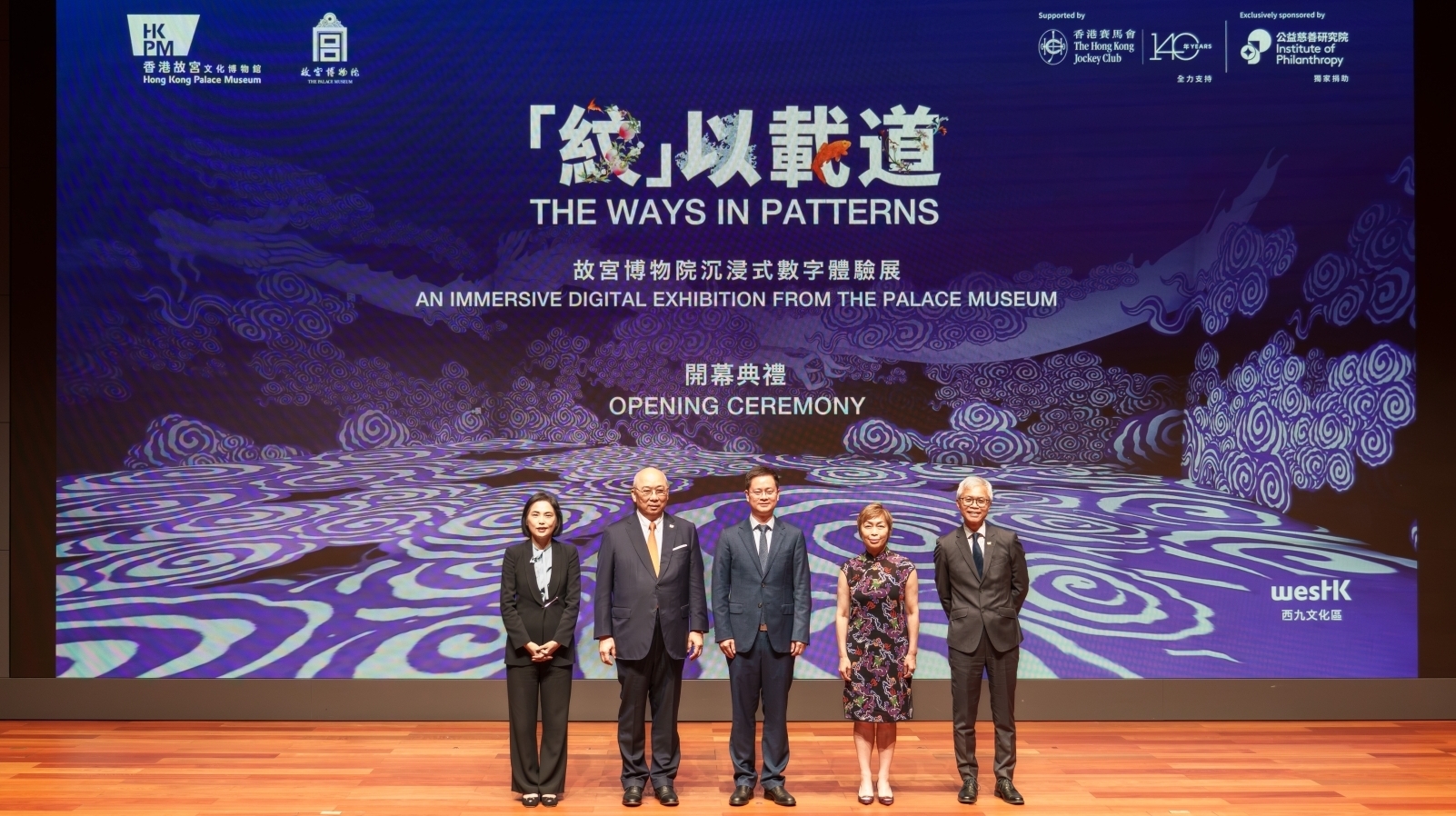
“The Ways in Patterns: An Immersive Digital Exhibition from the Palace Museum” Opens at the Hong Kong Palace Museum
On May 13, 2025, the opening ceremony for “The Ways in Patterns: An Immersive Digital Exhibition from the Palace Museum” was held at the Hong Kong Palace Museum (HKPM). The exhibition is jointly organized by the Palace Museum and the HKPM, and exclusively sponsored by the Institute of Philanthropy. Among the distinguished guests attending the ceremony were Luo Xianliang, deputy secretary of the Party Committee and deputy director of the Palace Museum, Leo Kung, chairman of the HKPM Board, Ann Kung Yeung Yun Chi, trustee of the Hong Kong Jockey Club Charities Trust and vice chairwoman of the Institute of Philanthropy, Betty Fung, chief executive officer of the West Kowloon Cultural District Authority, and Dr. Louis Ng, director of the HKPM.
This exhibition marks the first digital exhibition jointly organized by the Palace Museum and the HKPM. Themed around “patterns” and grounded in the concept of “immersion,” the exhibition draws traditional patterns from the Palace Museum’s architecture, ceramics, and embroidered textiles, reimaging them through cutting-edge digital technology, presenting both the cultural significance behind these traditional motifs and their contemporary artistic interpretations.
The exhibition seeks to showcase the beauty of traditional Chinese culture through the use of digital technology. It invites audiences to explore the charm of this culture from a new perspective and to witness the rebirth of traditional patterns in the digital age. Through dynamic lighting and shifting forms, auspicious motifs rich in cultural connotations, such as bat-and-peach symbols, sea-and-dragon designs, and intertwining lotus patterns, are brought to life with renewed vibrancy. Visitors may feel as if they were stepping into a dreamlike landscape constructed entirely of traditional patterns.
“The Institute of Philanthropy is committed to advancing the exchange and development of charitable endeavors nationally and globally. This exhibition represents a key milestone in our five-year cooperation plan with the Palace Museum. The initiative aims to promote fine traditional Chinese culture, nurture talent in arts technology, and strengthen Hong Kong’s position as a hub for international cultural exchange. The timing makes this event especially meaningful, as it coincides with both the Palace Museum’s centennial celebration and the Hong Kong Jockey Club’s 140th anniversary;” said Ann Kung Yeung Yun Chi.
Luo Xianliang expressed that the inaugural joint digital exhibition between the Palace Museum and the HKPM reflects their shared commitment to showcasing Chinese cultural treasures to audiences worldwide and promoting mutual understanding and respect between different cultures. He is eager to leverage digital technology to advance traditional culture in a global context.
Leo Kung said that traditional Chinese patterns are known for their enduring vibrancy and charm. “The Ways in Patterns” breathes life into the static motifs found in artifacts and architecture through technology, guiding audiences from around the world into an immersive world of elegance within traditional Chinese aesthetics. “The Ways in Patterns” is the third exhibition co-organised by the HKPM and the Palace Museum this year. The HKPM will continue to work with the Palace Museum to promote and preserve China’s rich cultural heritage through innovative curatorial approaches, further leveraging Hong Kong’s unique role in international art and cultural exchange.
Last May, the Hong Kong Jockey Club and the Institute of Philanthropy signed a memorandum of understanding (MOU) on cooperation with the Palace Museum. Titled “Promotion of Chinese Culture and Arts Tech Talent Development in the Mainland and Hong Kong,” the MOU outlines the Institute of Philanthropy’s commitment to promoting Chinese culture and values across Hong Kong, the Chinese mainland, and globally. It also supports initiatives aimed at developing talent in the art technology and cultural sectors. The exhibition is a key initiative under the collaboration, offering Hong Kong citizens and visitors an intimate opportunity to experience the Palace Museum culture while fostering meaningful cultural exchanges between the Chinese mainland and Hong Kong.
“The Ways in Patterns: An Immersive Digital Exhibition from the Palace Museum” will open to the public in Gallery 7 of the HKPM on May 14 and run through October 13, 2025.
2025-05-01
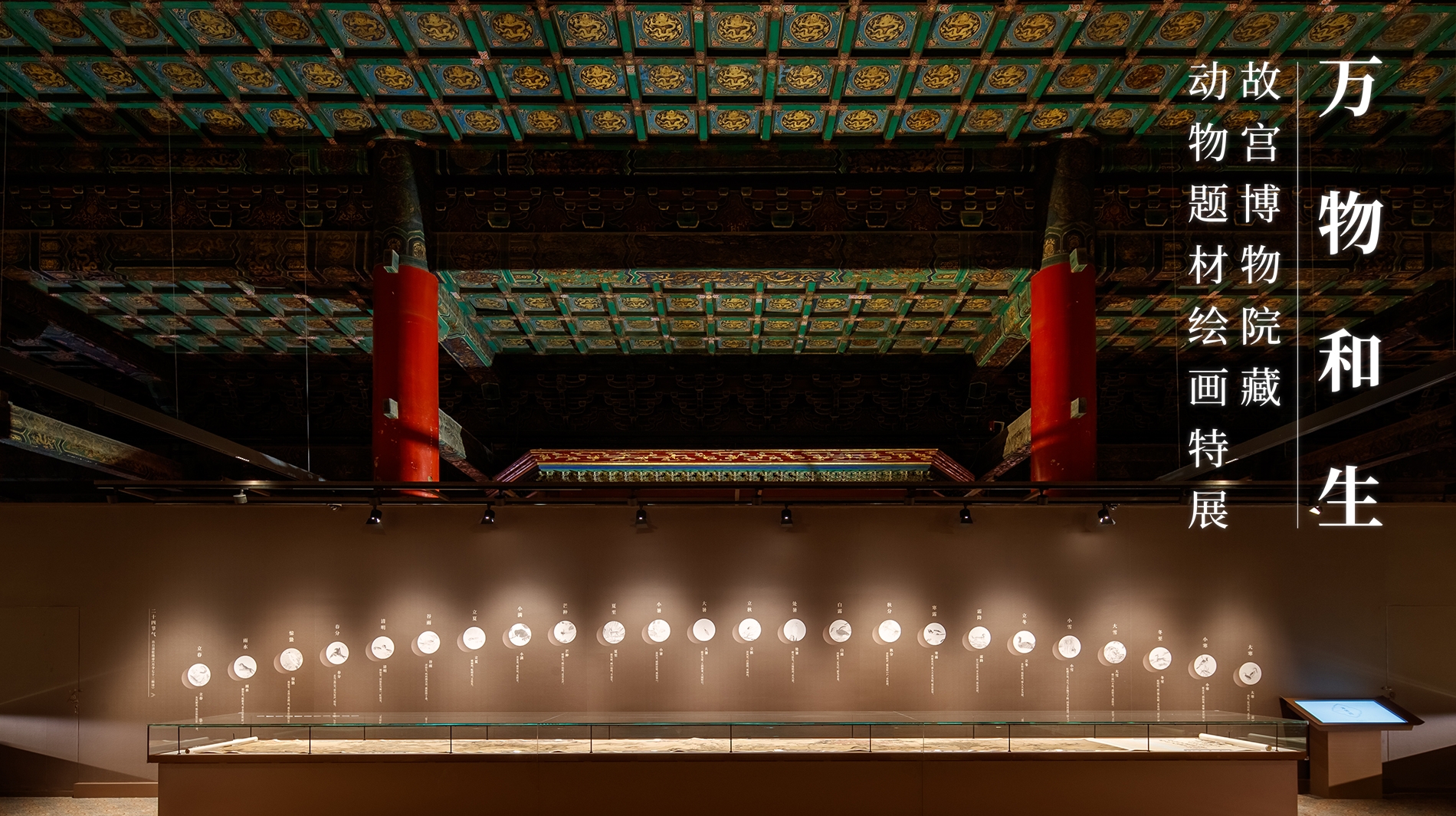
“All Beings Thrive in Harmony: A Special Exhibition of Animal-themed Paintings from the Palace Museum Collection” Opens at the Palace Museum
On April 30, the Palace Museum opened a captivating show titled “All Beings Thrive in Harmony: A Special Exhibition of Animal-themed Paintings from the Palace Museum Collection.” Set within the Gallery of Painting and Calligraphy in the Hall of Literary Brilliance (Wenhua dian), the exhibition will run for two months until June 29. It is fully supported by the Hong Kong Jockey Club and exclusively funded by the Institute of Philanthropy.
The title of the exhibition, “All Beings Thrive in Harmony,” is inspired by a line from the Warring States period philosopher Xunzi in his work “Discourse on Nature:” “All things that grow live in harmony and benefit from the nourishment of Nature.” This phrase expresses a vision of all life growing in harmony, each being nourished and thriving within a balanced natural order, a philosophy deeply rooted in ideals of unity, inclusivity, and the interconnectedness of all things. General Secretary Xi Jinping referenced this quote at the 2015 United Nations (UN) Climate Change Conference in Paris and at the leaders’ summit of the 15th meeting of the Conference of the Parties to the Convention on Biological Diversity (COP15), when commenting that biodiversity brings vitality to the planet and forms the foundation for human survival and development. Harmonious coexistence between humans and nature is a vital support of ecological civilization, with animals playing a critical role in this ecosystem.
This exhibition is the first time that the Palace Museum has showcased its extensive collection of animal-themed paintings. It is divided into three sections: “Spring Birds in Chorus,” “Dancing Beasts in Harmony,” and “Living Creatures in All Forms.” A total of 117 pieces from 63 sets of paintings, dating from the Five Dynasties period to the Qing dynasty, are included in the exhibition. The works cover a wide range of subjects, including birds, mammals, insects, and aquatic creatures. Highlights of the exhibition include “Sketches of Rare Birds” by Huang Quan from the Five Dynasties period, a representative work of the luxuriant and refined Huang family style. Also featured are rare court paintings from the Qing dynasty, such as the “Imperial Manual of Birds” and the “Imperial Manual of Beasts”, which were once part of the imperial collection. The exhibition presents work by renowned artists skilled in animal depiction, including Cui Bai, Emperor Huizong (Zhao Ji), Li Di, and Lin Chun from the Song dynasty; Zhao Mengfu, Ren Renfa, Wang Yuan, and Sheng Changnian from the Yuan dynasty; Bian Jingzhao, Shen Zhou, Lyu Ji, and Xu Wei from the Ming dynasty; and Jiang Tingxi, Hua Yan, Lang Shining, and Xu Gu from the Qing dynasty. These works are diverse in subject matter, style, and artistic schools. In terms of technique, the paintings range from the meticulous detail and rich colors of gongbi (realistic painting), to the graceful fluidity of mogu (boneless style, where forms are rendered without outlines), and the bold expressiveness of ink-and-wash painting, where brush and ink are used freely to evoke mood and movement. Through their depictions of animals, these artists conveyed emotions, reflected their inner worlds, expressed cultural identities, and captured the spirit of their times. As such, these paintings represent an integral part of Chinese traditional culture.
From birds soaring in the sky, to beasts running free, to fish gliding through water and insects singing in the grass, these paintings present classic Chinese aesthetic traditions that highlight the beauty of nature. The exhibition “All Beings Thrive in Harmony” not only honors generations of artists who found inspiration in the natural world, but also offers profound insights into our modern pursuit of ecological harmony. We invite all visitors to the Gallery of Painting and Calligraphy in the Hall of Literary Brilliance (Wenhua dian) to experience the beauty of life through the brushwork of masters across the ages and to reflect on the enduring bond between humans and animals.
Publication: “All Beings Thrive in Harmony: A Special Exhibition of Animal-themed Paintings from the Palace Museum Collection” Catalogue
As part of the exhibition, the Forbidden City Publishing House has published a catalogue that serves both as a reading material for general audiences and as a reference for professionals and scholars.
2025-04-30
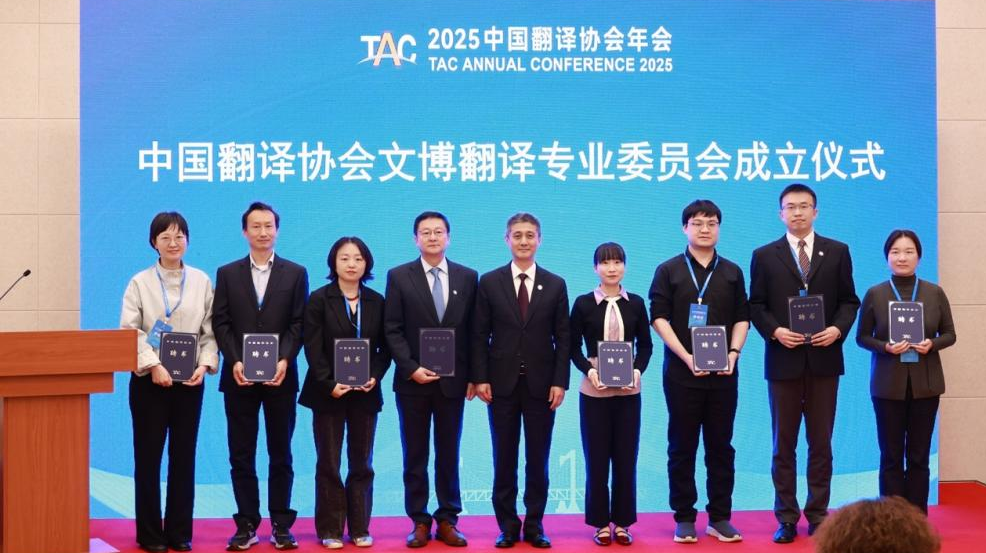
TAC Establishes Technical Committee on Cultural Heritage Translation
On April 24, a seminar focusing on translation in the museum and cultural heritage sectors was held in Dalian, Liaoning province. The event was jointly organized by the Translators Association of China (TAC), the Palace Museum, and the Academy of Translation and Interpretation (ATI) of China International Communications Group (CICG). Yuan Hong, deputy director of the International Exchange Department of the Palace Museum, presided over the meeting. Yuan is also the deputy chair and secretary-general of TAC’s Cultural Heritage Translation Committee. Gao Anming, editor-in-chief of CICG and executive vice president and secretary-general of TAC, and Wang Xiaohui, editor-in-chief of China Internet Information Center and vice president of TAC and chair of TAC’s Cultural Heritage Translation Committee, attended and delivered speeches. Nearly 200 experts and scholars in museum, cultural heritage, and international communication sectors attended the meeting.
Gao Anming, editor-in-chief of China International Communications Group and executive vice president and secretary-general of the Translators Association of China (TAC), delivers a speech at TAC’s annual conference of in Dalian, Liaoning province, April 24, 2025.
During the meeting, Gao Anming announced the establishment of TAC’s Cultural Heritage Translation Committee and presented letters of appointment to its leadership members. He said that the committee will serve as an important platform for further promoting the development of translation professionals, facilitating international exchange and cooperation, and accelerating the building of an international discourse system in the fields of museums and cultural heritage. Gao noted that this initiative is of great significance for promoting high-quality development in cultural heritage translation and international communication.
Wang Xiaohui, editor-in-chief of China Internet Information Center and vice president of the Translators Association of China (TAC) and chair of TAC’s Cultural Heritage Translation Committee, delivers a speech at TAC’s annual conference in Dalian, Liaoning province, April 24, 2025.
Wang Xiaohui noted that the establishment of the committee marks a significant milestone for China’s translation industry. He highlighted that effective cultural heritage translation requires depth in research, breadth in perspective, richness in knowledge, and dedication to practice. The committee will work toward standardization of translation related to museum and cultural heritage sectors and encourage greater participation in China’s cultural heritage translation efforts.
Gao Anming presents letters of appointment to the leadership members of the Cultural Heritage Translation Committee of the Translators Association of China (TAC) at TAC’s annual conference in Dalian, Liaoning province, April 24, 2025.
The meeting featured discussions on establishing standardized systems for translation and international communication in China’s museum and cultural heritage sectors. The agenda was compact yet rich in content. During the session of keynote speeches, speakers included Jiang Xiaochenyang, researcher at Peking University’s School of Archaeology and Museology, Shi Wanghuan, deputy director of the Exhibition Department at the China Cultural Relics Exchange Center, Xia Meifang, director of the Translation Office at the International Liaison Department of the National Museum of China, Yang Ruochen, staff member of the International Exchange Department of the Palace Museum, Zhang Liang, director of the Editorial Department of “The Museum” at the Capital Museum, Qin Su, deputy director of the Department of Major Translation Projects at ATI of CICG, and Luo Hongyan, chief translator at GTCOM Technology Corporation.
Yuan Hong, deputy director of the International Exchange Department of the Palace Museum and deputy chair and secretary-general of the Cultural Heritage Translation Committee of the Translators Association of China (TAC), presides over the seminar during TAC’s annual conference in Dalian, Liaoning province, April 24, 2025.
The leadership members of TAC’s Cultural Heritage Translation Committee come from a number of institutions. These include national organizations such as CICG, the National Cultural Heritage Administration, and the China Cultural Relics Exchange Center; cultural institutions such as the Palace Museum, the National Museum of China, the Dunhuang Academy, the Capital Museum, the Shanghai Museum, the Shaanxi History Museum, and the Henan Museum; universities such as Peking University, Beijing Foreign Studies University, the Communication University of China, and Jingdezhen Ceramic University; as well as cultural enterprises like Poly Culture Group Corporation Limited. The committee brings together members with complementary strengths and combines academic research with hands-on translation experience. As the host of the committee’s secretariat, the Palace Museum will collaborate with member organizations to carry out relevant work.
This seminar marks a new step toward standardized development of cultural heritage translation in China. Reflecting the richness of China’s 5,000-year civilization, the Palace Museum will continue to build its capacity for international communication and foster mutual learning among civilizations through translation. It aims to share more stories of cultural relics that reflect the essence of Chinese civilization with audiences around the world. The Palace Museum also hopes to become a global hub for cultural exchange and to explore new ways of connecting traditional Chinese culture with the achievements of other world civilizations.
Looking ahead, the Palace Museum will leverage its role as the secretariat of TAC’s Cultural Heritage Translation Committee to strengthen the development of translation professionals in the museum and cultural heritage sectors, enhance translation and international communication efforts, build a more advanced platform for cultural heritage exchange, and provide strong support for China’s cultural heritage sector to engage more effectively with the world.


